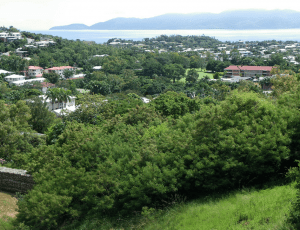Townsville stock agent Tim McHugh clocks up tens of thousands of kilometres each year behind the wheel of his Land Cruiser wagon, most of the time spent staring at the road ahead while keeping as close an eye as possible on the condition of the cattle and country he passes wherever he goes.
However a few weeks ago he got to spend some rare time in the passenger seat as his daughter drove him around the streets of Townsville practicing for a driving test.
He was surprised at what he saw. Not from his daughter’s driving – she’s going great and on track to get her license next week – but at the amount of Leucaena that he noticed now growing by road sides and along water courses throughout the city.
Farmed stands of Leucaena today are closely managed in accordance with an industry code of conduct that is designed to prevent seeds from spreading beyond planted sites.
However, a failure to control earlier introductions has led to infestations of wild growing Leucaena in several areas. Some regional councils have gone as far as to declare the forage tree as a weed.
The question that quickly took shape in Tim’s mind as he was chauffeured around Townsville last week was whether an opportunity exists to turn a negative into a positive, or in fact two positives, by harvesting unwanted Leucaena in council areas, and composting it for use as a much-needed source of protein for drought stricken cattle producers across the north.
On Tim’s behalf this week we asked the Queensland Department of Agriculture if it sees any merit in the idea.
A spokesperson said the Department appreciated all innovative suggestions about how to assist drought affected producers, particularly in relation to alternative or supplemental feed supplies.
However, in this instance it believed that harvesting Leucaena growing in Townsville and surrounds, particularly along the Ross River, did not present a cost effective or practical solution to the Leucaena infestation and /or lack of drought fodder problems.
This was because the trees were mature and well-established, some several metres high, which significantly reduced their suitability for supplemental feed.
Also, because of the weed potential of certain Leucaena species, as is the case with most trees in Townsville, any harvested product would be very restricted in where it could be moved.
It remains an interesting concept and one possibly worthy of further exploration.
On the seed issue, Mr McHugh’s view is that the process of composting or ensiling (ie converting chopped Leucaena into silage) would help to render seeds from the harvested Leucaena unviable, and therefore overcome the potential problem of further seed dispersal.
In his view, mixing composted Leucaena with molasses could provide a valuable source of protein and energy in the current dry conditions.
What do our readers think? Is there scope to use wild growing Leucaena as a viable drought fodder source? If you have any thoughts either in favour or against we’d like to hear from you , either in the comment section below or via email here.

